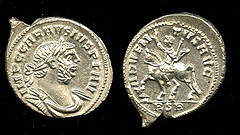In an astonishing turn of events, a trove of 52,000 Roman coins has been unearthed in the verdant countryside of Somerset, England. This significant discovery not only enriches our understanding of Roman Britain’s economic landscape but also ignites the imagination regarding the lives of those who once traversed these ancient streets. One might wonder: what stories do these coins hold? Each metallic disc, worn around the edges and stamped with intricate designs, carries with it a whisper of history, a narrative waiting to be recounted.
Found in a deceptively tranquil field, the coins have been dated to the late third and early fourth centuries CE, a period marked by the decline of Roman authority. Fascinatingly, the sheer quantity of this hoard suggests it was likely hidden away during a time of strife—perhaps in anticipation of invading forces or civil unrest. A pivotal question arises: was this stash meant as a safeguard or simply forgotten? Such inquiries underscore the complexities of human behavior during turbulent times.
The coins feature a variety of emperors and have been meticulously minted, showcasing the artistry and economic practices of the Roman Empire. From the recognizable visage of Emperor Carausius to lesser-known figures whose names have faded from collective memory, each coin exemplifies a blend of cultural exchange and imperial ambition. The diverse iconography not only highlights the craftsmanship of the period but also serves as a reminder of the expansive nature of the Roman economy, which integrated multiple cultures and communities within its borders.
Yet, as we celebrate this momentous find, challenges loom large. What will become of these ancient relics? Preserving such a vast collection poses significant logistical hurdles. Will these coins remain in situ, under the protection of the Earth, or will they be meticulously cataloged and displayed in a museum for posterity? Such decisions are not merely academic; they carry weighty implications for local heritage and national identity.
No seat in the world of archaeology is without its discomforts. The emotional turmoil of potential fragmentation between scholarly study and public enjoyment of heritage must be addressed. Enthusiasts will undoubtedly clamor for access to these artifacts, yet there exists a delicate balance to be struck. Moreover, how shall we educate the public about the significance of these coins without commodifying their value?
As the dust settles around this momentous discovery, the excitement lingers in the air. The 52,000 Roman coins from Somerset are not just relics; they are threads in the vast tapestry of history. This discovery offers a unique opportunity to reflect on the past while navigating the complexities of preservation for future generations. Indeed, history has a peculiar way of unfolding—a vault of questions yet to be answered, and the tales of our ancestors beckon us to listen.
